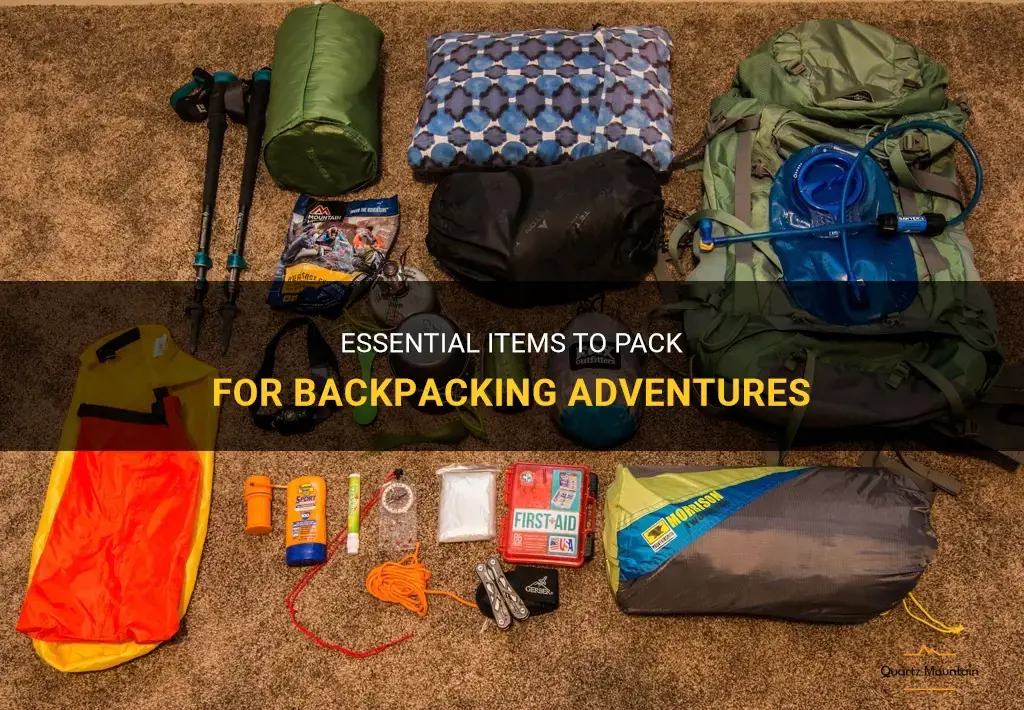
Are you planning your next exciting backpacking adventure? Whether you're a seasoned backpacker or new to the game, having the right items packed can make or break your experience. From practical necessities to unique gadgets, we've got you covered. In this guide, we'll explore the essential items you should pack for your backpacking adventure, ensuring you're fully prepared for whatever challenges or adventures lie ahead. So, grab your backpack and let's dive in!
What You'll Learn
- What essential items should I pack when backpacking?
- How can I determine what clothing to pack for various weather conditions while backpacking?
- What type of backpack should I use for backpacking, and what features should I look for?
- Are there any specific toiletries or hygiene products that are must-haves for backpacking?
- What safety items should I include in my backpack when backpacking in remote or rugged areas?

What essential items should I pack when backpacking?
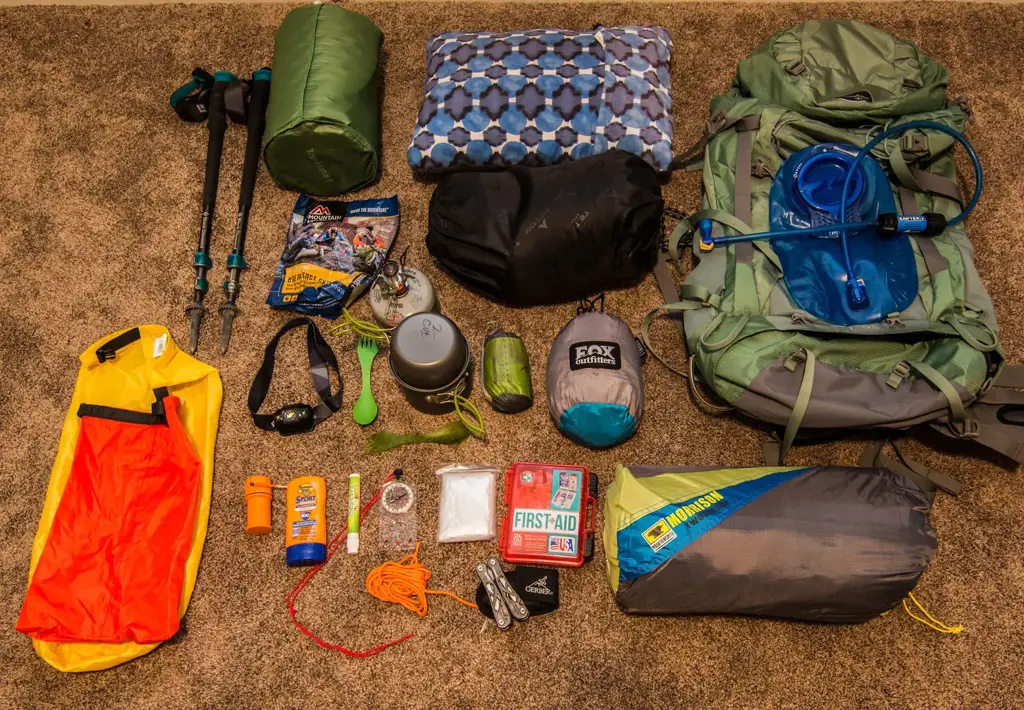
When embarking on a backpacking trip, it is essential to pack the right items to ensure a comfortable and safe journey. Whether you are planning a weekend hike or a months-long expedition, there are certain items that should always be on your packing list. Here are some essential items to consider when preparing for a backpacking adventure:
- Backpack: Choose a sturdy and comfortable backpack that fits your body well. Look for one with multiple compartments and adjustable straps to evenly distribute the weight of your gear.
- Tent: Unless you plan on sleeping under the stars, a lightweight and waterproof tent is a must. Look for one that is easy to set up and provides adequate protection from the elements.
- Sleeping Bag: Invest in a high-quality sleeping bag that is suitable for the climate you will be backpacking in. Consider factors such as temperature rating, size, and weight when making your selection.
- Sleeping Pad: A sleeping pad not only provides cushioning and insulation but also adds an extra layer of comfort to your sleeping setup. Look for one that is lightweight, compact, and durable.
- Clothing: Pack clothing suitable for the weather conditions you expect to encounter on your trip. Layers are key, as they allow you to adjust your clothing to stay comfortable throughout the day. Don't forget essentials like a waterproof jacket, thermal underwear, and a hat for sun protection.
- Footwear: Invest in a good pair of hiking boots or trail shoes that are comfortable and provide good ankle support. Make sure to break them in before your trip to avoid blisters and discomfort. Don't forget to bring along extra pairs of socks as well.
- Food and Water: Plan your meals and pack lightweight, non-perishable food items that are easy to prepare. Consider bringing a camping stove for hot meals. Additionally, make sure to carry an adequate supply of water or a water filtration system to stay hydrated throughout your trip.
- Navigation Tools: A compass and a topographic map are essential for navigating unfamiliar trails. Familiarize yourself with the route before setting out and carry a GPS or a phone with offline maps as a backup.
- First Aid Kit: Accidents can happen, so it is crucial to have a well-stocked first aid kit. Include items such as bandages, antiseptic wipes, pain relievers, and any personal medication you may need.
- Miscellaneous Items: Other essential items to consider packing include a headlamp or flashlight, a multi-tool, a whistle, sunscreen, insect repellent, toiletries, and a lightweight towel.
Remember, the key to a successful backpacking trip is to pack light while also ensuring you have all the essentials you need. Take the time to plan and prepare before your trip, and make sure to pack items specific to your destination and the activities you have in mind. By doing so, you will maximize your comfort and safety while enjoying the great outdoors.
Essential Items to Pack for Your Trip to Kenya
You may want to see also

How can I determine what clothing to pack for various weather conditions while backpacking?
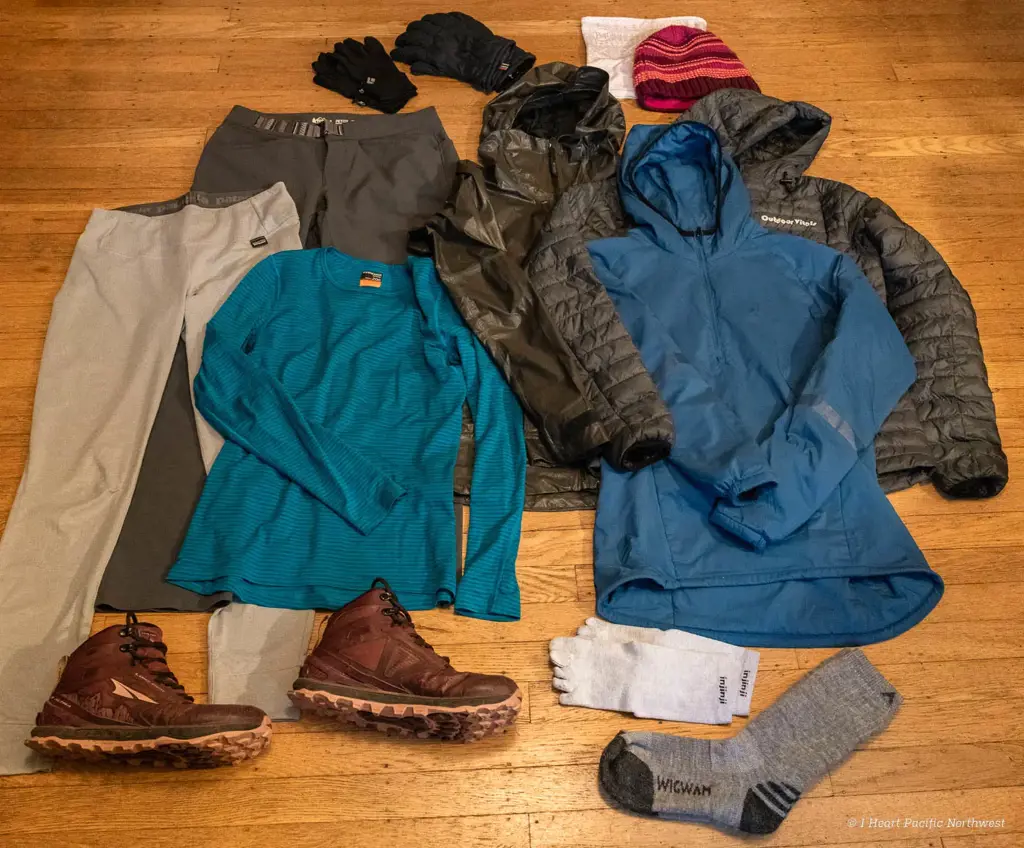
When backpacking, it is crucial to pack appropriate clothing for the various weather conditions you may encounter. Being prepared will ensure your comfort and safety throughout your trip. Here are some tips on how to determine what clothing to pack for different weather situations while backpacking.
- Check the weather forecast: Before your trip, check the weather forecast for the location you will be backpacking in. This will give you an idea of the average temperatures and any predicted precipitation. Keep in mind that weather conditions can change quickly, so it is always a good idea to be prepared for different scenarios.
- Dress in layers: Layering is key when it comes to backpacking clothing. Instead of packing one heavy jacket, opt for multiple thinner layers that can be easily added or removed depending on the temperature. Start with a moisture-wicking base layer to keep sweat away from your skin. Add a mid-layer such as a fleece or down jacket for insulation. Finally, top it off with a waterproof and breathable outer layer to protect you from wind and rain.
- Choose fabrics wisely: When selecting clothing for backpacking, choose fabrics that are lightweight, quick-drying, and breathable. Avoid cotton as it takes a long time to dry and can leave you feeling cold and uncomfortable if it gets wet. Instead, opt for synthetic materials such as polyester or nylon, or natural fibers like merino wool, which have excellent moisture management properties.
- Invest in quality gear: While it may be tempting to cut corners and buy cheap clothing for your backpacking trip, investing in quality gear will pay off in the long run. High-quality clothing will last longer, perform better, and provide greater comfort. Look for reputable outdoor brands known for their durable and functional products.
- Consider the activities you will be doing: Think about the specific activities you will be participating in while backpacking and pack accordingly. If you will be hiking in hot and sunny conditions, pack lightweight, breathable clothing with UV protection. For colder weather or high-altitude hiking, be sure to pack warm hats, gloves, and insulated clothing. If you will be crossing rivers or encountering wet conditions, consider packing quick-drying clothes or even a dry suit.
- Be prepared for unexpected weather: Even if the weather forecast predicts clear skies and sunshine, it is always wise to be prepared for unexpected weather conditions. Pack a lightweight, packable rain jacket that can easily be stowed in your backpack. Additionally, bring a hat and sunglasses for protection from the sun, and a warm hat and gloves for colder temperatures.
- Take into account the duration of your trip: The length of your backpacking trip will also impact how much clothing you need to pack. For longer trips, you may need to do laundry on the go or bring multiple sets of clothing. If you will be in remote areas without laundry facilities, consider packing clothing that can be easily washed and dried by hand.
In conclusion, determining what clothing to pack for different weather conditions while backpacking requires careful consideration. Checking the weather forecast, dressing in layers, choosing the right fabrics, investing in quality gear, considering the activities you will be doing, being prepared for unexpected weather, and taking the duration of your trip into account are all important factors to consider. By following these tips, you will be well-prepared and comfortable during your backpacking adventures.
Essential items to pack for exploring Patagonia's stunning landscapes
You may want to see also

What type of backpack should I use for backpacking, and what features should I look for?
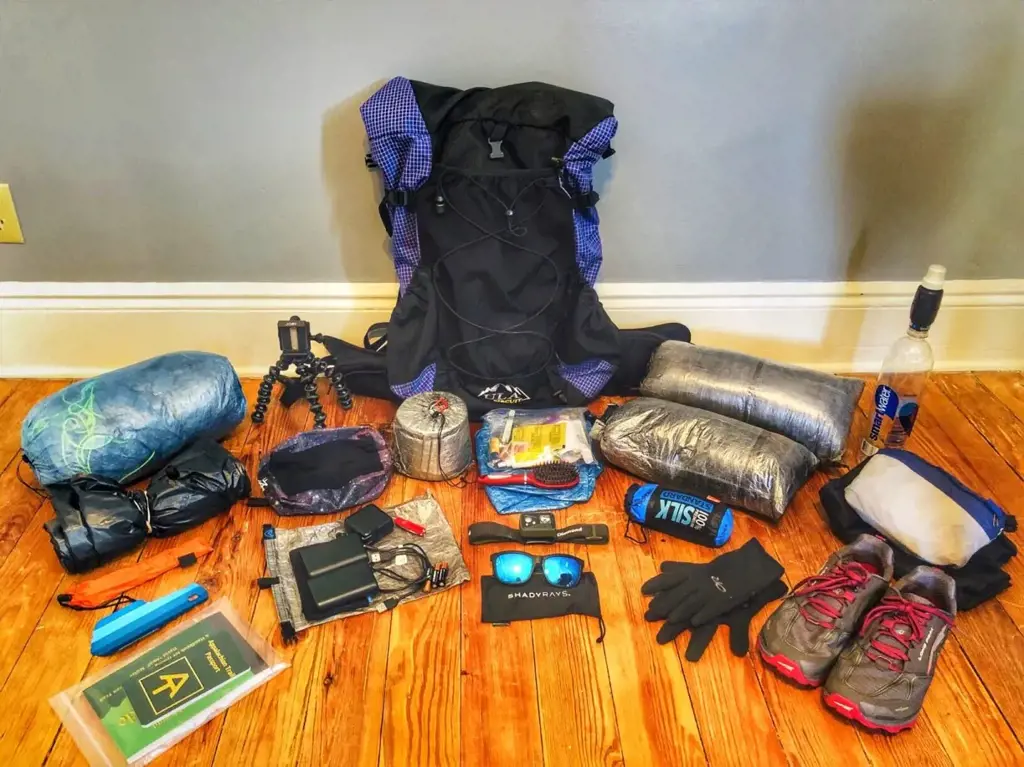
Backpacking is a popular activity, whether you're hiking through the mountains or exploring a new city. Choosing the right backpack is crucial for a successful trip, as it will be carrying all of your essentials. There are several factors to consider when selecting a backpack for backpacking, and in this article, we will explore the different types of backpacks and the features to look for.
Firstly, it is important to determine the type of backpack that is suitable for your needs. There are two main types of backpacks: internal frame backpacks and external frame backpacks. Internal frame backpacks have a built-in frame that provides support and stability. These backpacks are ideal for uneven terrain and are more versatile than external frame backpacks. On the other hand, external frame backpacks have a frame that is located on the outside of the backpack. These backpacks are generally bulkier and are best suited for carrying heavy loads on flat terrain.
Once you have determined the type of backpack you need, it is time to consider the features that are important for backpacking. One of the most important features is the size of the backpack. It is crucial to choose a backpack that can accommodate all of your gear without being overly bulky. A backpack with a capacity of around 40-70 liters is usually sufficient for most backpacking trips.
Another important feature to consider is the fit of the backpack. A properly fitting backpack will distribute the weight evenly across your hips and shoulders, reducing strain and fatigue. Look for backpacks that have adjustable shoulder straps, hip belts, and sternum straps to ensure a customized and comfortable fit. Additionally, consider a backpack with a padded back panel for increased comfort during long hikes.
The material and durability of the backpack are also significant factors to consider. Look for backpacks made from high-quality, rip-resistant materials such as nylon or polyester. These materials are lightweight, durable, and water-resistant, making them ideal for backpacking in various weather conditions.
Furthermore, consider the organizational features of the backpack. Look for backpacks with multiple compartments, pockets, and straps to help you organize your gear efficiently. Some backpacks even have separate compartments for sleeping bags or hydration systems, which can be convenient for long trips.
Lastly, consider the weight of the backpack itself. Remember that you will be carrying this backpack for extended periods, so it is important to choose one that is lightweight but still durable. Look for backpacks with lightweight materials and minimalist designs to minimize the overall weight.
To illustrate the importance of choosing the right backpack, let's consider an example. Sarah is planning a backpacking trip through the Rocky Mountains. She decides to invest in a high-quality internal frame backpack with a capacity of 60 liters. The backpack fits her comfortably and has adjustable straps for a personalized fit. The backpack is made from durable nylon material and has multiple compartments for easy organization. Sarah feels confident that her backpack will withstand the rigorous demands of the trip and comfortably carry all of her gear.
In conclusion, choosing the right backpack for backpacking is essential for a successful and comfortable trip. Consider the type of backpack, the size, fit, material, organizational features, and weight when selecting your backpack. With a well-chosen backpack, you can enjoy your backpacking adventures with ease and confidence.
Essential Items to Pack for a Memorable Sailing Trip
You may want to see also

Are there any specific toiletries or hygiene products that are must-haves for backpacking?
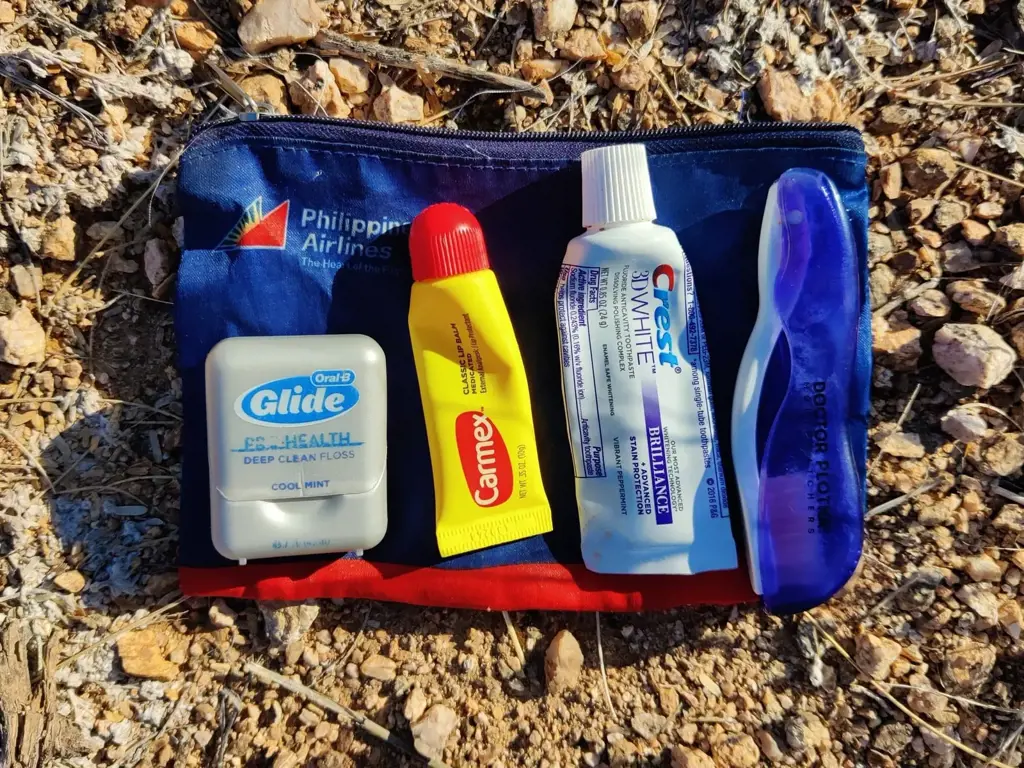
When it comes to backpacking, it's important to pack efficiently and bring only the essentials. Toiletries and hygiene products play a crucial role in maintaining cleanliness and staying comfortable while on the road. Here, we will discuss some must-have toiletries and hygiene products that are essential for backpacking.
- Travel-sized containers: The first item on your list should be travel-sized containers. These are small containers into which you can transfer your everyday toiletries such as shampoo, conditioner, and body wash. The compact size makes them convenient to carry and ensures that you don't have to lug around heavy full-size bottles.
- Biodegradable soap: When backpacking, it's important to consider the impact of your toiletries on the environment. Opt for biodegradable soap that is safe to use in natural water sources such as lakes or rivers. This way, you can maintain personal hygiene without harming the environment.
- Microfiber towel: A microfiber towel is a must-have item for any backpacker. These towels are lightweight, quick-drying, and compact, making them perfect for travel. Additionally, they are super absorbent and can dry you off effectively even with their small size. It's a good idea to choose a microfiber towel with antibacterial properties to keep it clean and odor-free during your trip.
- Travel-sized toothbrush and toothpaste: Oral hygiene is important even when you're on the go. Pack a travel-sized toothbrush and toothpaste to keep your teeth clean and fresh. Look for toothbrushes that come with a protective case to prevent them from getting dirty in your backpack.
- Hand sanitizer: Backpacking often involves being in remote locations with limited access to clean water and soap. Having a hand sanitizer is essential to keep your hands clean and prevent the spread of germs. Opt for a travel-sized bottle that you can easily carry in your backpack or pocket.
- Wet wipes: Wet wipes are a versatile item that can be used for various purposes while backpacking. They can be used for freshening up, wiping down surfaces, or even as a makeshift shower replacement. Look for eco-friendly or biodegradable options to minimize your impact on the environment.
- Deodorant: Staying fresh and odor-free is essential when you're on the road. Pack a travel-sized deodorant to keep sweat and body odor at bay. Look for antiperspirant varieties if you're going to be doing physical activities or hiking for extended periods.
- Sunscreen: Protecting your skin from the harmful effects of the sun is crucial, especially when you're spending long hours outdoors. Pack a travel-sized sunscreen with a high SPF to protect your skin from sunburn and minimize the risk of skin damage.
- Insect repellent: Backpacking often involves spending time in nature, which means encountering bugs and insects. An insect repellent is a must-have item to protect yourself from mosquito bites and other insect-related nuisances. Look for a travel-sized repellent with a high concentration of the active ingredient, such as DEET or picaridin.
- Menstrual products: For female backpackers, it's important to pack menstrual products such as tampons, pads, or menstrual cups. Plan according to your needs and the duration of your trip, ensuring you have an adequate supply to last the entire duration.
In conclusion, when it comes to backpacking, carrying the right toiletries and hygiene products is crucial. Travel-sized containers, biodegradable soap, microfiber towel, travel-sized toothbrush and toothpaste, hand sanitizer, wet wipes, deodorant, sunscreen, insect repellent, and menstrual products are some must-have items for any backpacking trip. Choose compact and lightweight options to minimize the weight of your backpack and ensure you have everything you need to stay clean and comfortable on your adventure.
What Clothes are Essential to Pack for Nashville in April?
You may want to see also

What safety items should I include in my backpack when backpacking in remote or rugged areas?
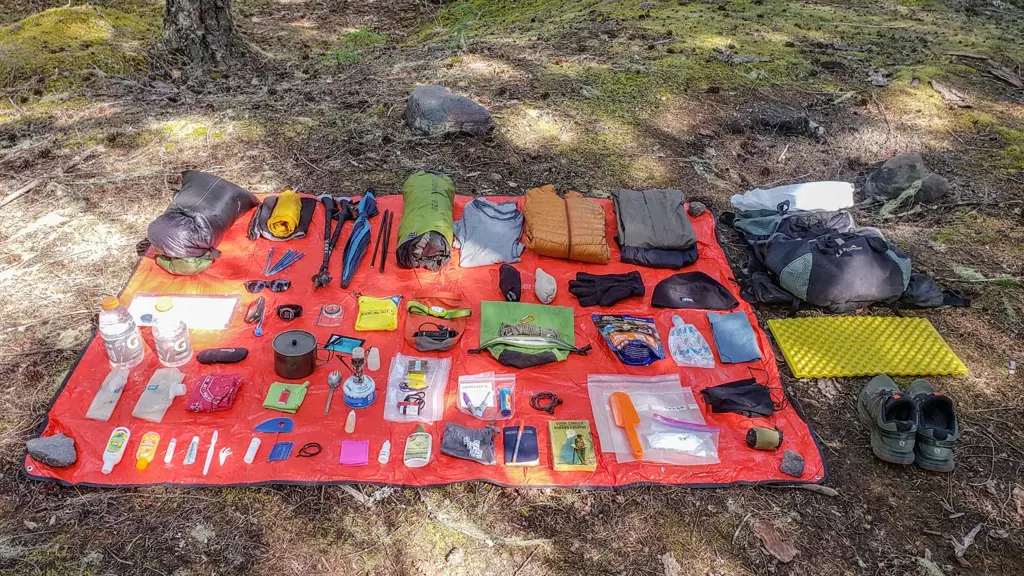
When backpacking in remote or rugged areas, it is essential to take safety precautions to ensure a successful and enjoyable trip. One of the most important aspects of backpacking safety is being prepared with the right equipment and supplies. In this article, we will discuss the safety items that should be included in your backpack when backpacking in remote or rugged areas.
- Navigation Tools: Having reliable navigation tools, such as a compass, topographic map, and GPS device, is crucial when backpacking in remote areas. These tools will help you stay on track and find your way, even if you encounter challenging terrain or unpredictable weather conditions.
- First Aid Kit: A well-stocked first aid kit is essential for any backpacking trip. It should include basic supplies such as bandages, disinfectant, painkillers, and blister care products. Additionally, it is important to have a basic understanding of first aid techniques and how to use the items in the kit.
- Emergency Shelter: In remote or rugged areas, it is essential to have a reliable emergency shelter in case of unexpected weather changes or other emergencies. This could be a lightweight tent or a bivy sack, depending on your preference and the anticipated conditions.
- Communication Devices: It is crucial to have a way to communicate with the outside world in case of an emergency. Carrying a mobile phone, a satellite phone, or a two-way radio is essential for emergency situations where you need to call for help.
- Water Purification System: Access to clean drinking water is vital when backpacking in remote areas. Carrying a water purification system, such as a water filter or water purification tablets, will help ensure that you have a safe water source throughout your trip.
- Extra Food and Emergency Rations: Having extra food and emergency rations is always a good idea when venturing into remote or rugged areas. Unexpected delays or getting lost can quickly deplete your food supplies, so it is essential to have enough to sustain you until help arrives or you find your way back.
- Protective Clothing and Gear: In remote areas, the weather can be unpredictable, and the terrain can be challenging. It is important to have the right clothing and gear to protect yourself from the elements. This includes a waterproof and windproof jacket, sturdy boots, sun protection, and extra layers for insulation.
- Lighting Equipment: Carrying a headlamp or flashlight is essential for navigating in low-light conditions or during emergencies. It is always a good idea to have spare batteries or a portable charger to ensure that your lighting equipment is functional throughout your trip.
- Fire-starting Kit: Having the ability to start a fire can be a lifesaver, providing warmth, light, and a way to cook food. Include items such as waterproof matches, a lighter, and tinder in your backpack.
- Personal Locator Beacon: In extreme remote or rugged areas, where cell phone coverage is limited or non-existent, a personal locator beacon (PLB) can be a valuable safety tool. A PLB sends a distress signal to search and rescue teams, enabling them to locate and assist you in case of an emergency.
Remember, when backpacking in remote or rugged areas, it is essential to assess the specific risks and challenges of the area, and customize your safety items accordingly. Additionally, ensure that you are familiar with how to use each item in your backpack before embarking on your backpacking adventure.
In conclusion, including the right safety items in your backpack when backpacking in remote or rugged areas is crucial for a safe and enjoyable trip. Navigation tools, first aid kits, emergency shelters, communication devices, water purification systems, extra food, protective clothing and gear, lighting equipment, fire-starting kits, and personal locator beacons are all important items that should be considered. By being prepared and equipped with these essential tools, you will be ready to handle any challenges that may arise during your backpacking adventure.
The Essential Family Vacation Packing Checklist: Don't Leave Home Without These Items
You may want to see also
Frequently asked questions
When packing for a backpacking trip, it's important to focus on clothes that are lightweight and versatile. Opt for quick-drying and moisture-wicking fabrics that can be easily layered. Pack a few pairs of comfortable and breathable pants or shorts and choose shirts that can be easily mixed and matched. Don't forget to pack a waterproof and windproof jacket, as well as a hat and sunglasses for sun protection.
It's best to stick to just one or two pairs of shoes when backpacking to save space and weight. Start with a comfortable pair of hiking shoes or boots that provide good traction and support. This is crucial for any hiking or walking activities you plan to do. As a backup, you can also pack a pair of lightweight and collapsible water shoes or sandals for taking showers or relaxing at the campsite.
When it comes to backpacking, it's important to pack light and only bring essentials. Start with a sturdy and comfortable backpack that can hold all your gear. Pack a lightweight and compact sleeping bag, a tent or hammock for shelter, a portable stove for cooking, and a water filtration system or water purifying tablets for clean drinking water. Don't forget to pack a first aid kit, a headlamp, a multi-tool, and a map or compass for navigation. Additionally, bring enough food and snacks to sustain you during the trip, along with a refillable water bottle.







